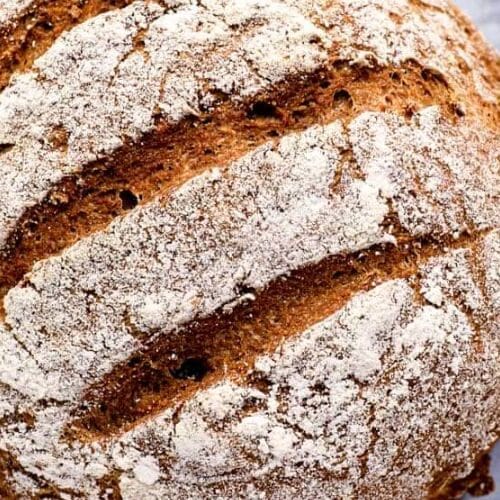
Gluten-Free Rye-Style Bread
This Gluten-Free Rye-Style Bread recipe offers a hearty and flavorful alternative to traditional rye bread, ideal for those who avoid gluten.The use of gluten-free flours, psyllium husk, and yeast provides a dense, slightly tangy loaf reminiscent of classic rye bread. Perfect for sandwiches, toasts, or served with soups, this bread is easy to make and fully customizable with optional spices for enhanced flavor.
Equipment
- Mixing bowls (2 large)
- Measuring cups and spoons (1 set)
- Stand Mixer or Hand Mixer (optional): 1
- Baking Pan (9x5-inch loaf pan): 1
- Parchment paper (1 sheet)
- Wire Rack: 1
- Wire Rack: 1
Ingredients
- 1 ½ cups 180g Sorghum Flour
- 1 cup 120g Rice Flour
- ½ cup 50g Oat Flour
- 2 tbsp 15g Psyllium Husk
- 2 tsp 6g Instant Dry Yeast
- 1 ½ tsp 9g Salt
- 1 ½ tsp 3g Caraway Seeds (optional)
- 1 tbsp 15g Apple Cider Vinegar (or lemon juice)
- 1 ¼ cups 300ml Warm Water (110°F/43°C)
- 2 tbsp 30ml Olive Oil (or any neutral oil)
Instructions
- Prepare the Dry Ingredients: In a large bowl, mix together the sorghum flour, rice flour, oat flour, psyllium husk, yeast, salt, and caraway seeds (if using). Set aside.
- Activate the Yeast: In a separate bowl, combine warm water and apple cider vinegar (or lemon juice). Stir and let it sit for about 5 minutes until the yeast begins to foam.
- Combine Wet and Dry Ingredients: Add the activated yeast mixture and olive oil to the dry ingredients. Stir well to combine, then use a stand mixer or your hands to knead the dough for 4-5 minutes. The dough will be sticky but should hold together.
- First Rise: Transfer the dough to a greased bowl, cover it with a damp towel, and place it in a warm, draft-free area. Let it rise for 1-2 hours, or until it has slightly puffed up (it won’t rise as much as traditional bread dough).
- Shape and Rest the Dough: Gently shape the dough into a loaf and place it in a greased 9x5-inch loaf pan lined with parchment paper. Cover it again with a damp towel and let it rest for 20-30 minutes.
- Preheat and Bake: Preheat your oven to 375°F (190°C). Bake the loaf for 40-45 minutes, or until the crust is golden brown and the internal temperature reaches about 200°F (93°C). The bread should sound hollow when tapped on the bottom.
- Cool: Remove the bread from the oven and allow it to cool completely on a wire rack before slicing. This ensures the texture sets properly.
Notes
- Adjust the Spices: Feel free to experiment with different spices like fennel or thyme to give your bread a unique flavor. Caraway seeds are the classic choice for rye bread, but other herbs can add a personal touch.
- Texture Variations: Gluten-free dough will be denser and stickier than traditional bread dough. If you prefer a slightly lighter loaf, you can experiment with adding more yeast or increasing the proofing time.
- Freezing Tips: This bread freezes well! Slice it before freezing so you can easily toast individual slices straight from the freezer.
- Storage: Store the bread in an airtight container at room temperature for 2-3 days. For longer shelf life, freeze it and thaw slices as needed.